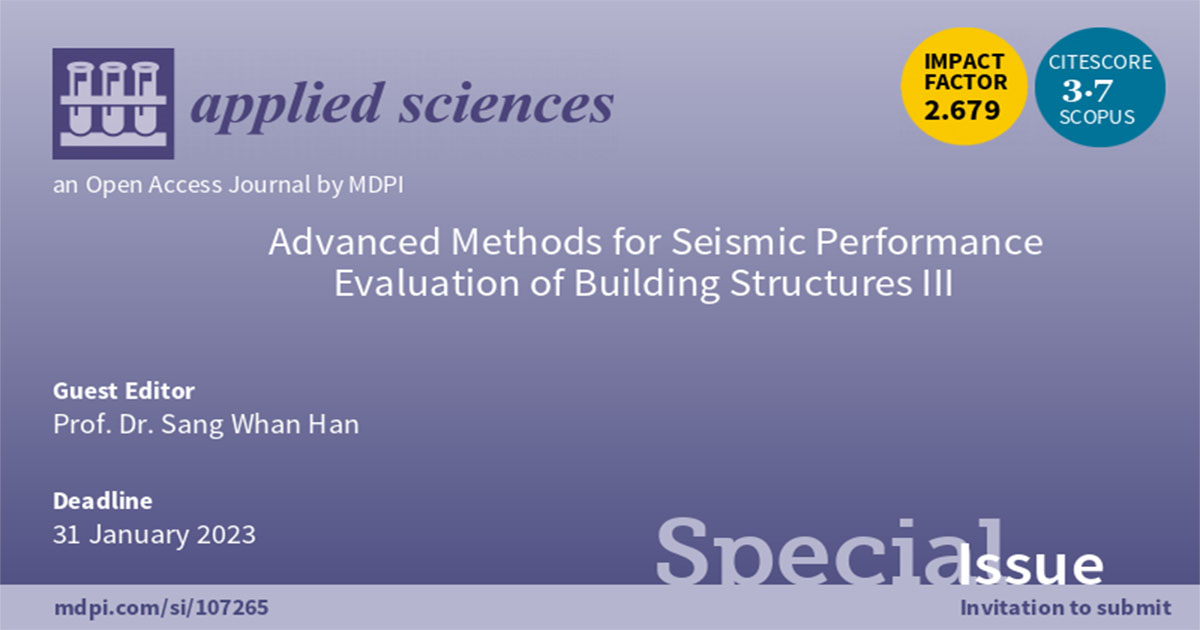- 2.5Impact Factor
- 5.5CiteScore
- 20 daysTime to First Decision
Advanced Methods for Seismic Performance Evaluation of Building Structures III
This special issue belongs to the section “Civil Engineering“.
Special Issue Information
Dear Colleagues,
Earthquakes are one of the most dangerous natural events, inflicting damage and causing the collapse of buildings and infrastructure. On average, 10,000 people lose their lives from earthquakes each year. Not only do earthquakes come in different sizes, they can also occur anywhere on the globe. The demand to reduce the risk associated with earthquakes has been growing every year, leading to greater research focus on seismic design and seismic performance evaluation. Recently, the performance-based seismic engineering approach has been adopted in the earthquake engineering community. In this approach, multiple seismic performance objectives are explicitly specified, which are defined with combinations of seismic hazard levels and structural and non-structural performance levels, unlike conventional prescriptive design approaches. Critical components of performance-based seismic design and evaluation procedures include state-of-art technologies related to seismic hazard analyses, robust numerical simulation frameworks, and sophisticated performance-based seismic design and assessment methodologies. Although major technologies have been developed, many challenging obstacles remain to be solved before they can be implemented in code provisions. The Special Issue of Applied Sciences on “Advanced Methods for Seismic Performance Evaluation of Building Structures III” aims to cover recent advances in the development of major components of seismic performance evaluation and design.
Prof. Dr. Sang Whan Han
Guest Editor
Manuscript Submission Information
Manuscripts should be submitted online at www.mdpi.com by registering and logging in to this website. Once you are registered, click here to go to the submission form. Manuscripts can be submitted until the deadline. All submissions that pass pre-check are peer-reviewed. Accepted papers will be published continuously in the journal (as soon as accepted) and will be listed together on the special issue website. Research articles, review articles as well as short communications are invited. For planned papers, a title and short abstract (about 250 words) can be sent to the Editorial Office for assessment.
Submitted manuscripts should not have been published previously, nor be under consideration for publication elsewhere (except conference proceedings papers). All manuscripts are thoroughly refereed through a single-blind peer-review process. A guide for authors and other relevant information for submission of manuscripts is available on the Instructions for Authors page. Applied Sciences is an international peer-reviewed open access semimonthly journal published by MDPI.
Please visit the Instructions for Authors page before submitting a manuscript. The Article Processing Charge (APC) for publication in this open access journal is 2400 CHF (Swiss Francs). Submitted papers should be well formatted and use good English. Authors may use MDPI's English editing service prior to publication or during author revisions.
Keywords
- numerical models
- model parameters
- analysis algorithm
- seismic performance evaluation
- seismic risk
- seismic hazards
- seismic force-resisting systems
- energy dissipaters
- seismic design and mitigation
- assessment method
- ground motions
- nonlinear response

Benefits of Publishing in a Special Issue
- Ease of navigation: Grouping papers by topic helps scholars navigate broad scope journals more efficiently.
- Greater discoverability: Special Issues support the reach and impact of scientific research. Articles in Special Issues are more discoverable and cited more frequently.
- Expansion of research network: Special Issues facilitate connections among authors, fostering scientific collaborations.
- External promotion: Articles in Special Issues are often promoted through the journal's social media, increasing their visibility.
- e-Book format: Special Issues with more than 10 articles can be published as dedicated e-books, ensuring wide and rapid dissemination.

